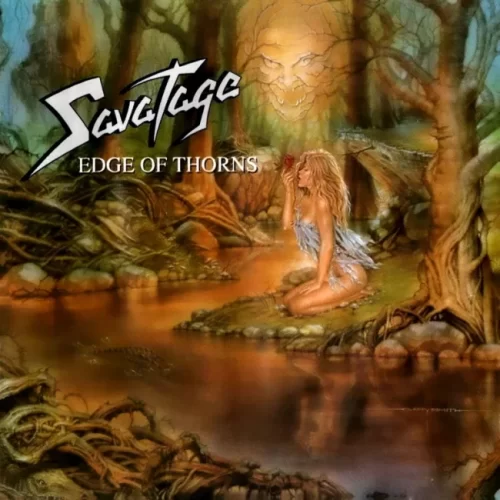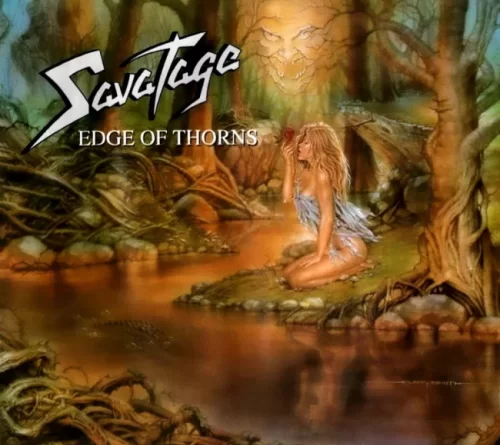HEAVY MUSIC HISTORY: Edge Of Thorns – Savatage
As the ‘90s unfurled before them, SAVATAGE were on the edge of burnout. Having spent the best part of a decade carving out their own spot on the metal scene, the band had evolved from a straight-ahead metal outfit in to something far more grandiose. Much of this shift was thanks to the tutelage of producer Paul O’Neill, whose guiding hand brought out the best in founding members Jon and Criss Oliva. Through O’Neill’s influence, SAVATAGE’s sound expanded to incorporate a wider range of inspirations from classical to Broadway. In particular, the albums Gutter Ballet and Streets saw SAVATAGE deliver on the unique voice they had always promised. Centre-stage was the articulation of that voice, Jon Oliva – a vocalist who could bounce from maniacal rage to heartfelt desperation in the space of a single song.
However, the years of touring and Jon Oliva’s notoriously wild lifestyle had taken its toll. Simply put, Oliva’s voice was shot. In 1992, Jon officially left his position as singer of SAVATAGE, the band he had founded with his brother Criss many years before. “I just needed to get away from SAVATAGE,” Oliva reflected in 2010. Of course, while he was officially out, Jon didn’t go far. The plan was for him to take a year off from touring, but still write the next SAVATAGE record with his brother and O’Neill, and be there in the studio to contribute and co-produce. After that, he’d return to the fold and the Floridian outfit would become a two-singer band.
With Jon no longer front and centre, the Olivas and O’Neill made a conscious decision for the next album to become a showcase for guitarist Criss. The younger Oliva brother had always spellbound audiences with his flashy and melodic playing, but as SAVATAGE’s records progressed, Criss’s tight riffing was competing more and more with Jon’s melancholy pianos. Jon told Criss, “This is a chance for you to step up and take some of the spotlight. This is going to be your record.” With Jon’s departure, Criss’s guitars would provide a thread of continuity for long-time fans. Additionally, a pivot back to guitar-driven metal felt like the right call after Streets: A Rock Opera (1991) – but the band were hardly going to abandon the progressive tendencies they’d picked up along the way. Their next step forward, Edge Of Thorns, was taking shape.
The majority of Edge Of Thorns’ recording saw the band back home in Florida at their old haunt Morrisound Recording. Florida was outside the gaze of the press, and meant the Olivas and O’Neill could drill the group’s new singer, Zak Stevens, undisturbed. Handpicked by the three, Stevens had been part of a little-known outfit WICKED WITCH and, through mutual friends, had crossed paths with SAVATAGE during their last couple of tours. Another deliberate directional change by the Olivas and O’Neill, Stevens’s voice was a marked contrast to Jon’s. Smoother than Oliva but just as powerful, there was something nostalgic about the deeper tones that Stevens delivered. It didn’t have the crazed edge that Jon Oliva could muster, but it was emotional in its own way. A different voice to play with opened up new melodic possibilities for the band and, by O’Neill’s own admission, meant that Stevens could stand on his own strengths rather than be constantly compared to Jon.
It was at least six months of work before SAVATAGE’s creative core let Stevens cut any takes for the record, but the results were clearly paying off. The material making up Edge Of Thorns was still very SAVATAGE, but was making a marked shift towards the progressive. Although heavy in their own way, songs like Skraggy’s Tomb and Follow Me felt more drawn out and considered than the band’s early days. So much so that, after the Florida sessions wrapped up, the Olivas and O’Neill wrote and recorded two heavier cuts in New York to ensure the album was still what SAVATAGE fans would expect. Other songs like Conversation Piece and All That I Bleed would prove to be precursors for the dramatic and emotive direction the band would build towards throughout the ‘90s.
But it was the title track that remains the album’s most iconic. The descending piano tinkling of the Edge Of Thorns married with crunchy riffs had the Olivas’ touch all over it, but the melodious tones of Stevens added an accessible romanticism to the song. Released as a single, Edge Of Thorns saw SAVATAGE finally get the radio attention they had always craved – a particularly tough pill to swallow for Jon Oliva who had suspected his voice was what kept the band off the airwaves. Despite this being a post-Nevermind America, SAVATAGE’s bold new chapter was quickly reaping rewards for the band. They charged forward with touring in Europe and, buoyed by the success of the single, returned state-side to play a number of shows. After years of struggle, for once the stars started to align for SAVATAGE. But it simply wasn’t to be.
Although they didn’t know it, this line-up of the band would hold their last performance on home turf in Clearwater, Tampa on October 10 1993. A week later, Criss Oliva and his wife Dawn were involved in a collision with a drunk driver which sadly killed Criss. Just like that, SAVATAGE’s new beginning had been cut short in the most tragic way possible. Edge Of Thorns, an album conceived to be a spotlight for the guitarist, would become Criss Oliva’s musical epitaph; a testament to one of metal’s most melodically gifted guitar virtuosos. While the future for SAVATAGE was now unclear, Jon Oliva and Paul O’Neill resolved to keep the band going. In the latter’s own words, “We realised the best memorial for Criss Oliva was to keep his music alive.”

Edge Of Thorns was originally released on April 2, 1993 via Atlantic Records.
Like SAVATAGE on Facebook.

